Key takeaways:
- Coding burnout can stem from pressure to deliver perfection, repetitive tasks, and lack of work-life balance.
- Identifying signs of burnout includes dwindling enthusiasm, inability to focus, and emotional irritability.
- Effective strategies to combat burnout involve time management, prioritizing passion over obligation, and seeking community support.
- Creating a balanced routine, incorporating breaks, and engaging in self-care activities are essential for recovery from burnout.
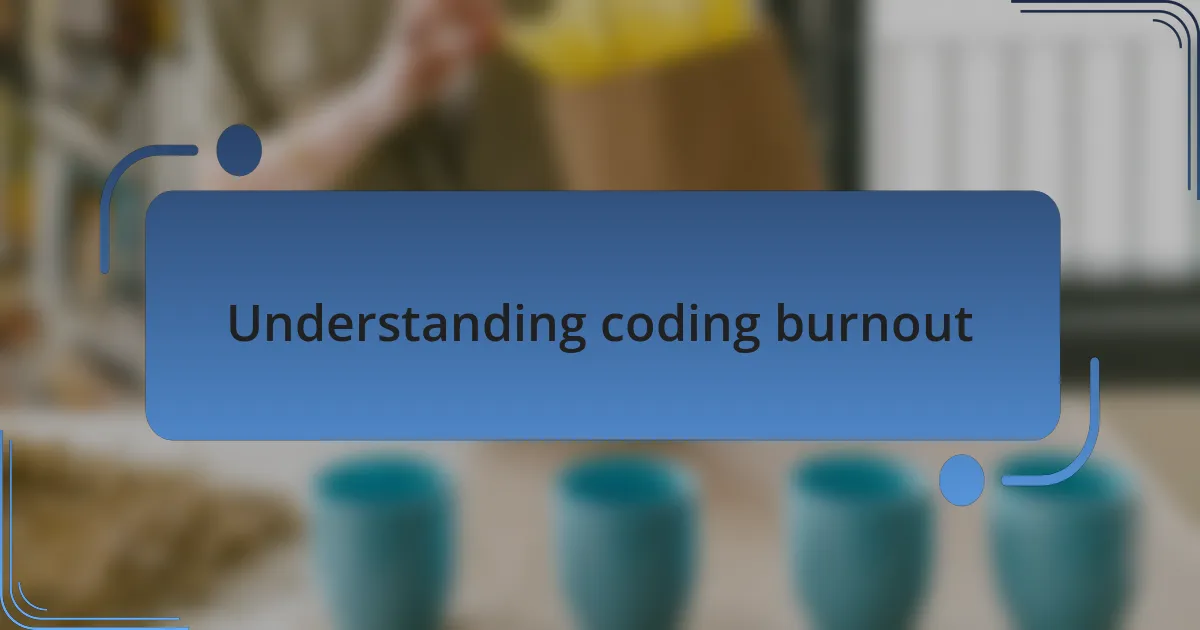
Understanding coding burnout
Coding burnout is a state I’ve found myself in more times than I’d like to admit. Picture this: staring blankly at the screen for hours, frustrated by mistakes that seem trivial yet insurmountable. It’s that feeling of exhaustion that creeps up when the passion I once had for coding feels more like a heavy burden than a thrilling challenge.
I remember a time when I was knee-deep in a project, excited at first but soon overwhelmed by deadlines and my need to be perfect. I often wondered, “Why can’t I just enjoy what I used to love?” It dawned on me that the pressure I put on myself to produce flawless work played a significant role in my burnout. Did I really need to have every line of code be a masterpiece?
It’s disturbing how subtly burnout can manifest, blending into your daily routine like an unwelcome guest. I’ve noticed that when I’m burnt out, even small tasks become monumental. Have you ever felt that nagging sense of dread before opening your development tools? Understanding this creeping sensation is crucial; it’s a signal that it’s time to step back and reassess what truly drives my passion for coding.
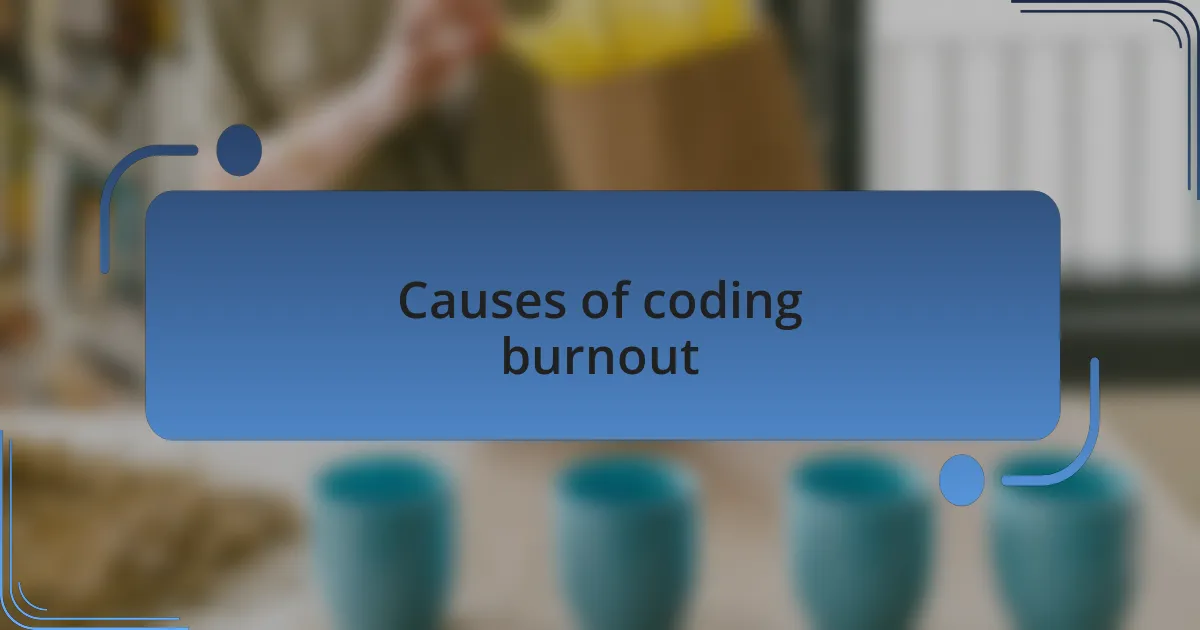
Causes of coding burnout
Coding burnout has many potential causes that can creep in without warning. One of the most significant factors is the relentless pressure we often put on ourselves. In my own journey, I can recall the days when the thought of meeting tight deadlines filled me with anxiety rather than excitement. It was as if each line of code became a measure of my worth, leading to a vicious cycle where productivity and self-criticism were intertwined. Have you ever found yourself questioning your skills based on the speed of your output?
Another culprit is the monotony of repetitive tasks. I’ve had projects where I was stuck in a loop of similar coding patterns day after day. Eventually, that familiarity turned stale, drowning my creativity and replacing it with a sense of dread. Reflecting on it now, I realize how crucial variety is in keeping the spark alive. Do you remember the last time you tried a new coding technique or tackled a different project? Sometimes, breaking the mold is all it takes to rejuvenate our passion for code.
Lastly, the lack of work-life balance is often a silent killer of motivation. I’ve experienced nights where I was glued to my screen long after I should have called it a day, pushing myself to deliver more. It was a moment of exhaustion that made me question, “Is this worth my well-being?” Recognizing the importance of stepping away is vital; a break is not a sign of weakness but a step toward maintaining the passion that ignited our coding journey in the first place.
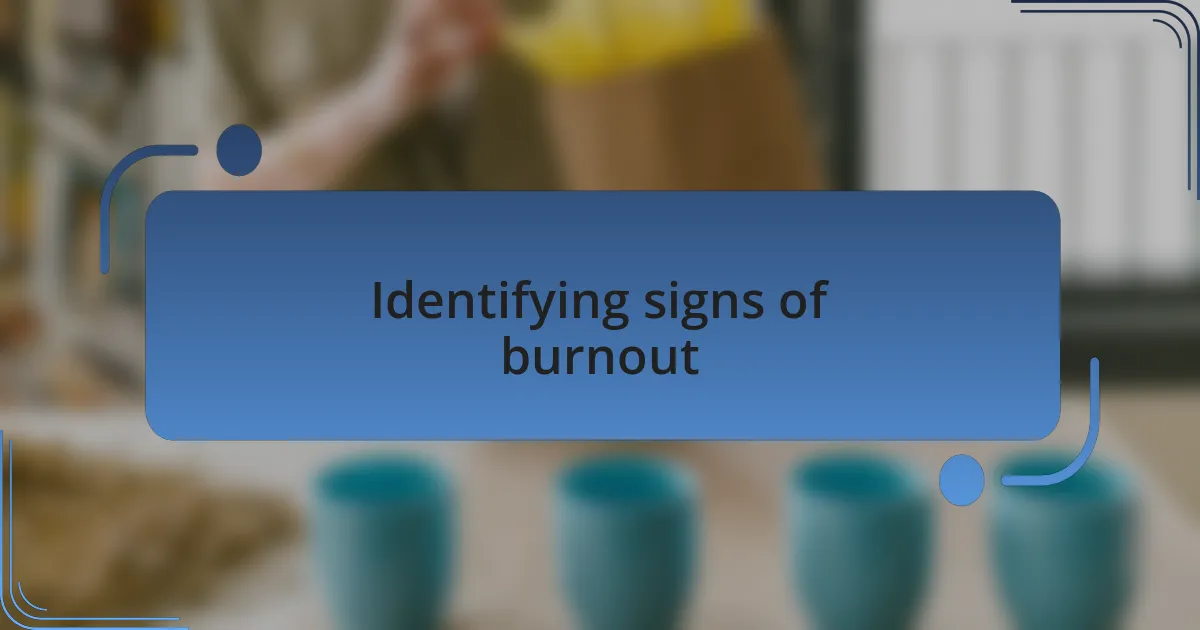
Identifying signs of burnout
One of the first signs I began to notice when I was burning out was my dwindling enthusiasm for coding. I remember being excited about projects, but then it transformed into a sense of obligation. Have you ever found yourself dragging your feet to start coding? That feeling is a clear indicator that something is off.
Another red flag was my declining ability to focus. Days where I spent more time staring at the screen than actually producing code were alarmingly common. I could feel the weight of fatigue settling in, making even simple tasks feel monumental. It’s like trying to run a marathon with a heavy backpack—how could I expect to perform at my best when my energy source was depleted?
Emotional signs can also be quite telling, and for me, it manifested in irritability and impatience. I would snap at colleagues over minor issues, and my love for collaboration faded away. What I learned is that when coding becomes frustrating instead of fulfilling, it might be time to step back and assess the situation. If you’ve experienced something similar, it’s essential to acknowledge those feelings and take action before they spiral further.
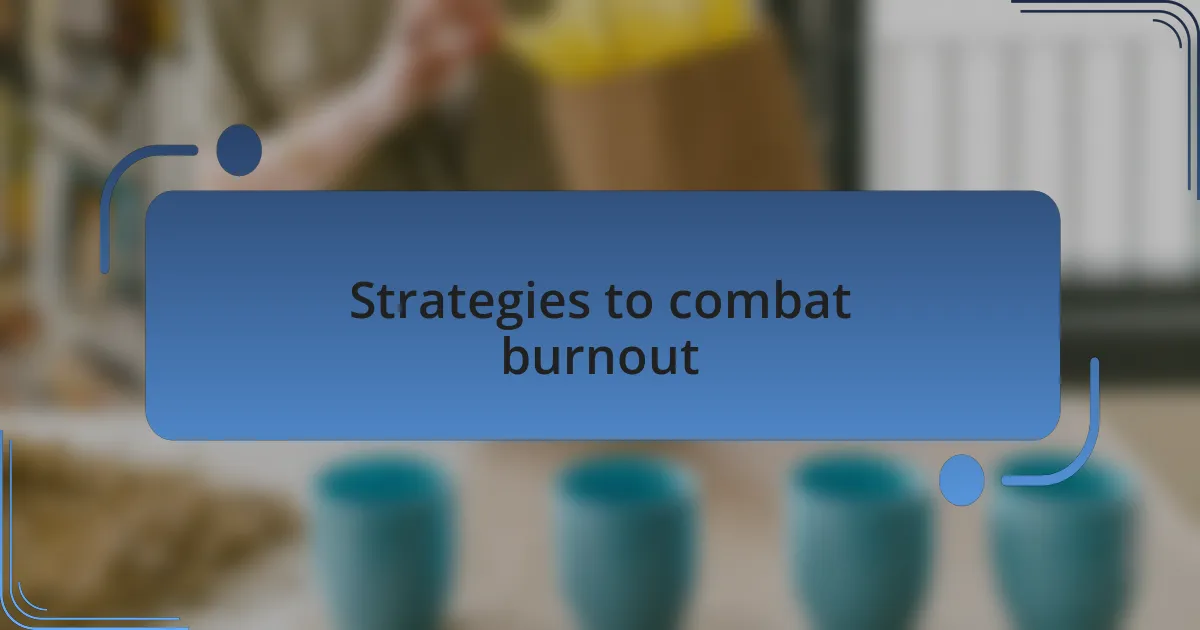
Strategies to combat burnout
When I recognized that I was deep in the throes of burnout, I turned to time management techniques. Breaking my day into focused sprints with scheduled breaks helped immensely. I would set a timer for 25 minutes to code, followed by a 5-minute break to stretch or grab a coffee. It wasn’t just about productivity; those small breaks gave my mind a chance to recharge. Have you tried something like that?
Another powerful strategy for me was re-evaluating my projects. I started prioritizing tasks based on passion rather than obligation. Working on something that truly sparked my interest reignited my enthusiasm for coding. I can recall a project that had been lingering—the moment I shifted my focus onto something I loved, the lines of code started flowing again, and I felt that excitement bubbling up. Isn’t it amazing how passion can re-invigorate our work?
Lastly, I leaned heavily on community support. Sharing my struggles with fellow developers made a world of difference. I remember venting in a group chat and hearing others voice the same feelings. Their experiences reassured me that I wasn’t alone, and their encouragement gave me the push I needed to take a step back and regain perspective. Have you sought support from colleagues or friends during tough times? It’s a remedy I couldn’t recommend more.
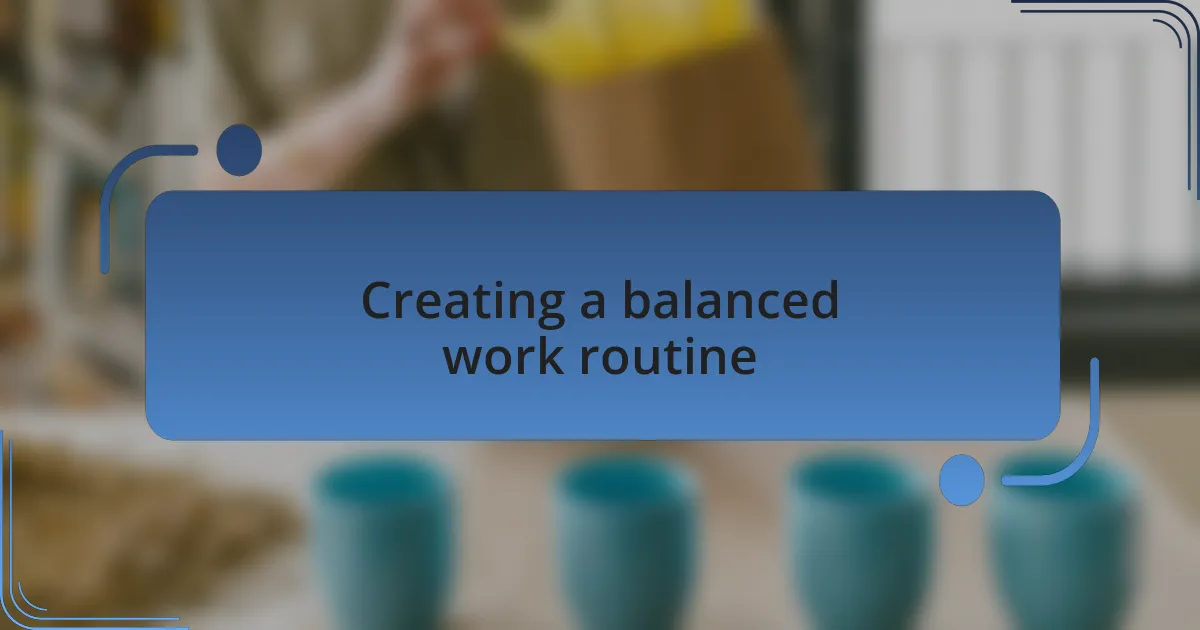
Creating a balanced work routine
Creating a balanced work routine emerged as a lifeline during my struggle with burnout. I began scheduling my day around a consistent routine that earmarked specific hours for coding, creativity, and, most importantly, downtime. I vividly remember the first day I embraced this structure—I finished my coding tasks faster and felt less mentally drained. Isn’t it fascinating how a little organization can completely transform our productivity?
As I further refined my routine, I included dedicated sessions for physical activity. Taking a brisk walk or practicing yoga allowed my body to reset and refuel my mind. I still recall the surge of clarity I experienced after stepping outside for just 15 minutes. That connection with nature, however brief, seemed to bring fresh ideas and energy to my workflow. Have you ever noticed how a change of scenery can refresh your perspective?
Additionally, I learned to respect boundaries by clearly defining my work hours. In the early days of my career, I often blurred the lines between work and personal time, which only fueled my burnout. Once I started leaving my work behind at a set time each day, I found that I could truly enjoy my evenings without the weight of unfinished tasks hanging over me. It’s empowering, really—what would it take for you to establish those boundaries in your own routine?

Incorporating breaks and downtime
Incorporating breaks into my routine felt like a game changer. I remember the first time I set a timer for a 10-minute break after every hour of coding. Initially, I hesitated, thinking it might slow me down. But to my surprise, those brief moments away from the screen revitalized my focus and creativity. It’s amazing how stepping back can actually propel you forward.
There were days when I’d get so engrossed in my work that I’d forget to take breaks entirely. I once hit a wall during a particularly long coding session, staring blankly at my monitor. It was in that moment of frustration that I realized I needed to step away—literally and figuratively. A short walk around my neighborhood not only cleared my mind but sparked ideas I hadn’t considered before. When was the last time you gave yourself permission to unplug?
Downtime is not just about physical breaks; it’s also about mental shifts. By incorporating activities unrelated to coding, like reading or sketching, I gave my brain the chance to reset. I still cherish evenings spent immersed in a good book, where I could feel my thoughts become less cluttered. Have you ever experienced that sense of renewal after taking time for your passions? It’s profound how these moments of leisure can infuse your work with new energy and enthusiasm.
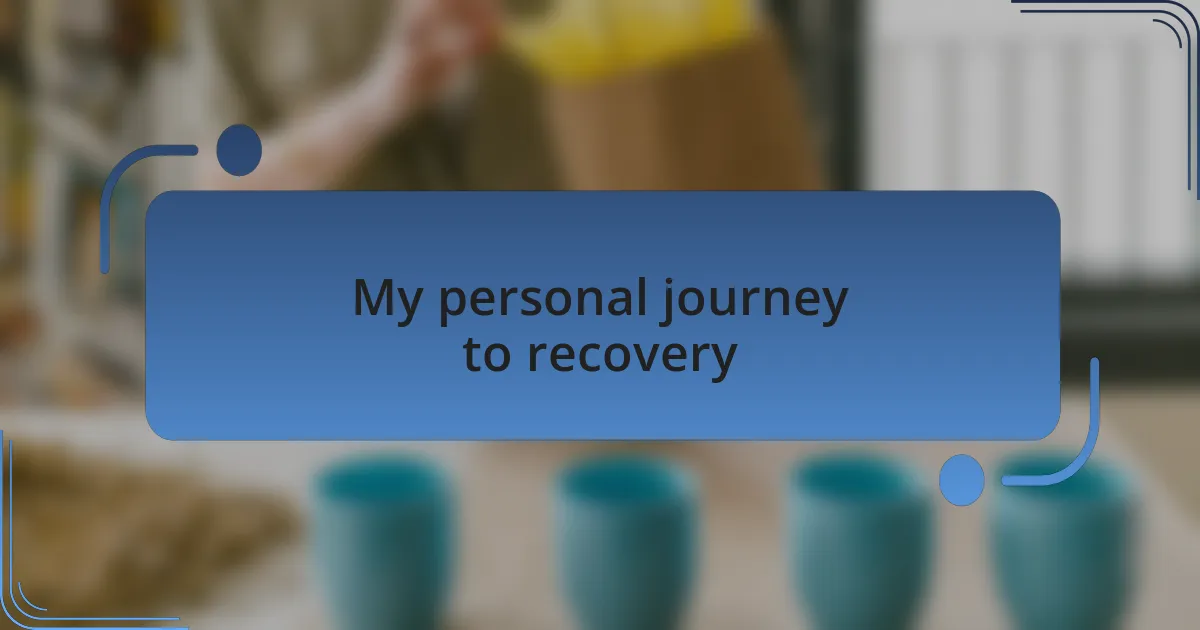
My personal journey to recovery
My journey to recovery from coding burnout was an eye-opening process. I vividly remember the day I acknowledged my exhaustion. It was one of those weeks where I found myself glued to the screen, working late into the night. I could feel the weight of burnout pressing down on me like a thick fog. In that moment, I decided no project was worth sacrificing my well-being, and I made a conscious choice to prioritize self-care.
I still recall one Saturday when I fully embraced a “digital detox.” I turned off my devices and spent the day outdoors. The simple act of hiking through the woods was transformative. I could hear the rustling leaves and feel the fresh air invigorating my spirit. It was during that hike that a pivotal realization struck me—sometimes the best solutions come when you disconnect and allow your mind to wander freely. Have you ever noticed how nature can become a muse after a long stretch of coding?
As I navigated my recovery, I started journaling my thoughts and emotions. This practice became a safe space to reflect on my experiences and setbacks. Writing about my journey helped me recognize patterns of stress and regain clarity. When was the last time you documented your feelings? I found that putting pen to paper not only eased my mind but also led to insights about what truly motivates and inspires me in my work. This blend of reflection and active self-care was essential in transforming my relationship with coding, turning it from a source of stress back into a passion.